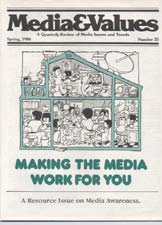MINORITIES: Insinuating Images Influence Perceptions
|
This article originally appeared in Issue# 35
|
The mass media have long influenced the popular image of minorities. From the 19th century's slanted journalism and caricaturing ethnic cartoons to the insinuating imagery of contemporary motion pictures and television, the media have contributed powerfully to the way that minority groups are viewed, including the ways minority members view themselves.
Scholars have demonstrated the mass media's impact on perceptions of ethnic groups, for better and for worse. For example, one pioneering study of the 1930s found that the derogatory depiction of blacks in the classic silent film, The Birth of a Nation, increased the prejudice of young children toward black Americans.
A later study looked at the effects of the film, Gentleman's Agreement, which criticized anti-Semitism, on college students. The result was improved attitudes toward Jews, even though most of the students stated that the film had not changed their attitudes!
A more recent study found that white children felt that TV comedies like The Jeffersons accurately portrayed black family life. Yet many of these same children admitted that the blacks they knew were different from these TV shows. They concluded that the blacks they knew were the exceptions. TV was the reality.
American ethnic groups have long recognized and challenged the image-creating power of the media. In 1911, Native American extras in the film, Custer's Fight, marched out of a preview of the movie to protest its degrading portrait of Indians.
The National Association for the Advancement of Colored People publicly attacked Birth of a Nation upon its release.
More recently, angered by the gratuitously violent films about minority gangs. Chinese Americans protested against the Year of the Dragon and Cuban Americans challenged the 1983 remake of Scarface.
Moving beyond protests, minorities have become increasingly active in creating their own media images, for example, TV is popular Bill Cosby Show, Hispanic newspapers and national magazines, and the brilliant little 1982 Chinese-American film, Chan Is Missing.
This all points to one clear fact. Minorities recognize how powerful the media have been in shaping their popular images and, therefore, influencing their destinies.



